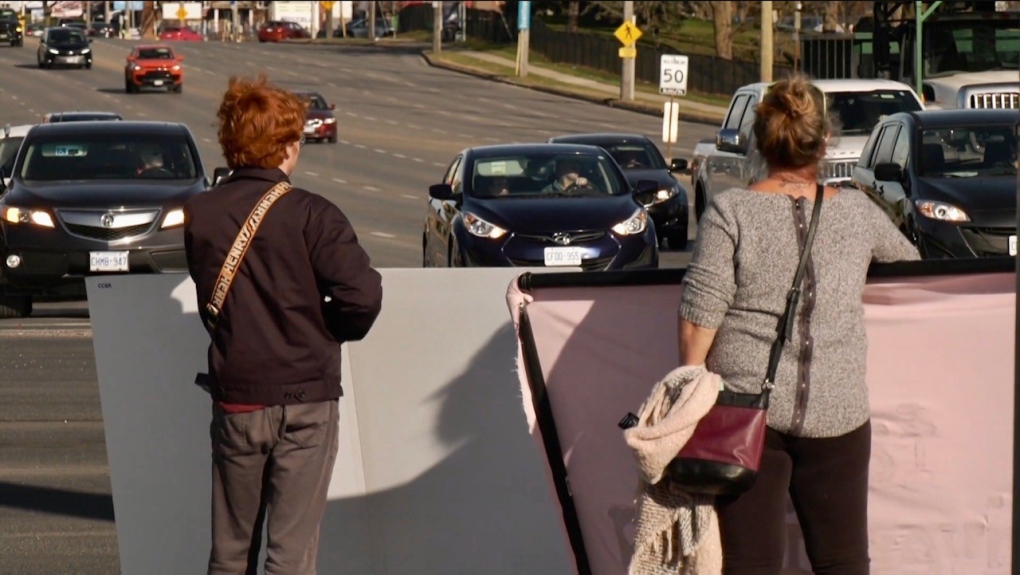London by-law banning graphic anti-abortion signs from public spaces considered in early 2024
 Graphic anti-abortion images being displayed along Wellington Road in London, Ont. in November of 2020. (File)
Graphic anti-abortion images being displayed along Wellington Road in London, Ont. in November of 2020. (File)
A motion by a pair of first-term councillors doubles down on work already nearing completion by city staff.
On Tuesday, the Community and Protective Services Committee considered a motion by Coun. Hadleigh McAlister and Coun. Sam Trosow that aims to update the Streets By-law to forbid the display of graphic images in public spaces, including sidewalks.
Graphic images would be defined as fetuses or parts of fetuses.
McAlister has received complaints about pro-life activists holding graphic posters of fetuses along roadways.
“The public display of graphic images can cause harm to the residents of London,” McAlister explained.
He said anyone who has lost a pregnancy for any reason could be triggered and re-traumatized by the tactic.
Trosow added, “It causes the inability of people to focus. It causes distress.”
The committee was informed that city staff are already preparing a report based on a motion passed during the last term of city council.
In August 2022, the previous council directed staff to report back with, “potential changes that could be made to the Sign By-law related to the prohibition of the display of graphic images in public.”
A report and public participation meeting are anticipated in the first quarter of 2024.
“When you’re driving down the street and all of a sudden there’s something on the side of the road, or impeding your use of the sidewalk,” said Coun. Elizabeth Peloza. “So I’m looking forward to the staff report that they have been working on for quite some time.”
After the meeting, McAlister said his motion will benefit the work already underway.
“There’s concerns we’ve heard directly from our constituents in terms of the language they would like to see, knowing that work was already underway, we just wanted to have that called out so staff could include that in their report,” he said.
In a news release, the Abortion Rights Coalition of Canada (ARCC) said that it has been urging council to address the roadside displays for years, “The research has already been done, and an amendment to this by-law is now three years overdue. We call on the London City Council to approve this amendment at the earliest opportunity.”
In November 2020, Deanna Ronson, a current ARCC board member, presented a petition to the committee with over 5,000 signatures calling for both an amendment to the Sign By-law and an amendment to ban the delivery of graphic flyers.
London banned graphic flyers from being delivered to unsuspecting households in May of 2022.
Several other cities have followed with similar by-laws.
Meanwhile, 4LifeLondon warned its members in an online communication that, “This is a major violation of the freedom of expression of London's pro-life community, and a blatant attempt to halt any public discussion of abortion in our city.”
The pro-life organization’s message added, “It's also a very expansive proposal, for it would make ultrasound imagery or any other healthy images of pre-born babies illegal to display in any form.”
But as a law professor, Trosow took time during the committee to address those sorts of legal concerns.
He read from the Canadian Charter of Rights and Freedoms and then explained the Oakes Test, which stems from a Supreme Court ruling about ‘reasonable’ limits on Charter rights.
He believes the motion to ban the public display of graphic images can meet that legal requirement.
“You have to have a sufficiently important objective,” he said. “This is why I am requesting a public participation meeting.”
The motion was unanimously supported by the committee (5-0).
CTVNews.ca Top Stories

Ministers Joly, LeBlanc travel to Florida to meet with Trump's team
Two members of Prime Minister Justin Trudeau's cabinet will be in Palm Beach, Fla., Friday to meet with members of Donald Trump's team.
India alleges widespread trafficking of international students through Canada to U.S.
Indian law enforcement agencies say they are investigating alleged links between dozens of colleges in Canada and two 'entities' in Mumbai accused of illegally ferrying students across the Canada-United States border.
Teen actor Hudson Meek, who appeared in 'Baby Driver,' dies after falling from moving vehicle
Hudson Meek, the 16-year-old actor who appeared in 'Baby Driver,' died last week after falling from a moving vehicle in Vestavia Hills, Alabama, according to CNN affiliate WVTM.
Pizza deliverer in Florida charged with stabbing pregnant woman at motel after tip dispute
A pizza deliverer in central Florida has been charged with pushing her way into a motel room with an accomplice and stabbing a pregnant woman after a dispute over a tip, authorities said.
Christmas Eve stowaway caught on Delta airplane at Seattle airport
A stowaway was caught trying to nab a ride on a Delta Air Lines plane at Seattle-Tacoma International Airport on Christmas Eve.
2 minors, 2 adults critically injured in south Calgary crash; incident was preceded by a robbery
Multiple people were rushed to hospital, including two minors, in the aftermath of a serious vehicle collision on Thursday morning.
Hwy. 401 off-ramp shut down due to Boxing Day deal-hunters now re-open
A Highway 401 off-ramp west of Toronto that became so clogged up with Boxing Day deal-hunters Thursday that police had to shut it down out of safety concerns has re-opened.
Cat food that caused bird-flu death of Oregon pet was distributed in B.C.: officials
Pet food contaminated with bird flu – which killed a house cat in Oregon – was distributed and sold in British Columbia, according to officials south of the border.
Aviation experts say Russia's air defence fire likely caused Azerbaijan plane crash as nation mourns
Aviation experts said Thursday that Russian air defence fire was likely responsible for the Azerbaijani plane crash the day before that killed 38 people and left all 29 survivors injured.
































